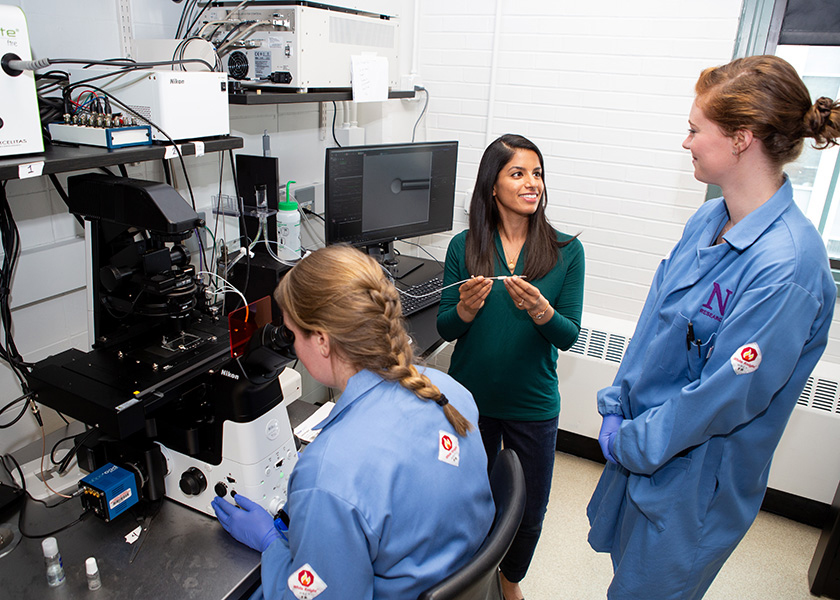Harnessing Biological Sensors Outside the Cell
The work could lead to novel biosensors with applications in diagnostics and environmental monitoring
Biological sensors are crucial to survival. Like eyes and ears, they help us process the world and protect us from danger. On a smaller scale, biological sensors such as nerves send signals to the brain that allow our bodies to react to outside factors, perhaps some we don’t even perceive.
New work from Northwestern Engineering’s Neha Kamat could lead to novel biosensors, potentially supporting breakthroughs in diagnostics and environmental monitoring.
Led by Justin Peruzzi (PhD ’23), together with undergraduate student Nina Galvez, the team harnessed a major bacterial sensory system called "two-component systems" and recapitulated its function outside of the cell. While there is a variety of emerging work using cellular parts to build sensors, a significant gap in these sensors has been the difficulty in using membrane proteins, sensors that sit in the cell membranes of all organisms.
“This inability to use membrane proteins was a big problem, because we were basically unable to use nature’s best sensors in technological applications,” Kamat said. “Our work illustrates a way to use membrane proteins outside of the cell and importantly, in a way that allows for signal transduction to gene expression systems. So we can design reactions that not only sense an analyte or biological signal of interest, but we can design genetic circuits that convert that detection event into the synthesis of a specific RNA or protein molecule. We see this work opening the door to a wide range of new biological sensors.”

Kamat is an assistant professor of biomedical engineering at the McCormick School of Engineering and a member of the Center for Synthetic Biology. A former student in Kamat’s lab, Peruzzi is a technology development scientist at Boston-based AI Proteins. Galvez is an undergraduate researcher in Kamat’s lab. The team reported its work in the paper “Engineering Transmembrane Signal Transduction in Synthetic Membranes Using Two-Component Systems,” published earlier this month in the Proceedings of the National Academy of Sciences.
Many bacteria use two-component systems to respond to their surroundings and survive. Accordingly, there are two-component systems that respond to a wide range of signals from hormones to light to pH changes to metals and more. This typical two-component system has two parts, where one component resides in the bacterial cell membrane and senses environmental changes in its surroundings. Upon detection, the membrane component activates a second component, called the response regulator, which can travel to the genome to initiate RNA and protein synthesis or turn certain genes off.
This sensory system helps the bacteria survive and thrive in different environments.
“In the early days of our lab, I saw a talk by Rice University professor Jeff Tabor, who is an expert in two-component systems and has been studying and engineering these systems in living bacteria,” Kamat said. “I was captivated by the potential of these systems to expand how we design biosensors and wondered if we could recreate their functions outside of a living cell.”
By leveraging membrane and protein design, this work helps reveal how transmembrane sensing can be recapitulated outside of the cell, adding to the arsenal of deployable cell-free systems primed for real-world biosensing.
Kamat and her teammates acquired plasmids for a nitrate sensing two-component system from Tabor and investigated how bacterial two-component systems can be leveraged to enable transmembrane-signaling with synthetic membranes. In the paper, the researchers demonstrated that a bacterial two-component nitrate-sensing system can be reproduced outside of a cell using synthetic membranes and cell-free protein expression systems. By moving this sensory system outside of the cell, it could become possible to sense signals that would normally kill a living cell, embed the sensors in materials, or engineer and optimize them to outperform their native functions.
Using their method, Kamat and Peruzzi discovered the impact of changing membrane lipids on the performance and sensitivity of the two-component system. They found that the specificity of the nitrate sensor could be tuned by altering the lipids used to make membranes, which changed the biophysical properties of the membranes and made the sensor more customizable and receptive to alterations that could lead to biosensor improvements. This allowed the team to not only use these sensors outside of living cells, but they can now potentially optimize the performance of other two-component systems by finding the ideal lipid composition for a given two-component system.
“By leveraging membrane and protein design, this work helps reveal how transmembrane sensing can be recapitulated outside of the cell, adding to the arsenal of deployable cell-free systems primed for real-world biosensing,” Peruzzi said.